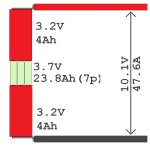I have a friend is is redoing an oldish campervan to live in for the foreseeable future.
For his battery pack to power all his stuff hes going with 3.6KWh lead-acid battery. which I think was going to be around $400 range.
I said why not go 18650 lithium, I worked out from nkon.nl it would be about $1100 for about 3.3KWh but of course its going to have around 3-4 times more total cycles and be lighter and require less space.
But for him its all about the upfront cost rather than the long-term cost as we all can see if you're going to be using it long term then you actually save money with the lithium because you're going to be able to use it 3-4 times as long.
And this is where OUR bias sets in vs Lead Acid.. And this is where I argue its the EXACT same thing with supercapacitors. If you can overcome the voltage drop problem and the charging problem and the space problem (which you can in a hybrid or pure setup for a campervan at least) then why wouldn't you want a "battery pack" that can do 1million cycles, as we know that is going to last much longer.
Because if a hybrid that does the heavy discharge work from the capacitor should save the batteries lifecycles significantly.
We all know that high discharge kills Lithium longevity/lifecycles, even on that other forum the guy forum was saying "lipo only has 200cycles" but we all know thats only true if you beat the shit out of it in heavy draw and its the exact same thing with 18650s as this chart shows with a modern 20700 cell.
For me its been frustrating argument because I don't mind people saying "I don't really care about the environment, I don't care about saving money in the long run, I just want convenience, a simple lithium/SLA battery is just far easier to manage etc." Because again, how can you compare even 2000 cycles vs 500,000 cycles to 1million cycles?
And I FULLY accept that, I am the exact same type of person, we pretty much all are, but I never ever seen anyone admit that, and I don't understand why that is so hard.
https://youtu.be/CzqmWgBSrHE?t=10m55s
Just watching that video on that all in one 3.55KWh supercap, looks very impressive and promising.
As he says at this point, hes been charging and discharging it about every 50minutes for months now and there hasn't been any degrading in total capacity.
[youtube]CzqmWgBSrHE[/youtube]



